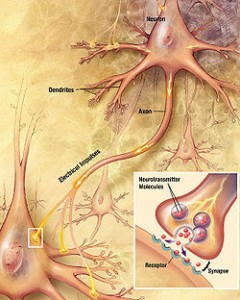 A new study published on February 1 in the journal PosS One has found that Alzheimer’s Disease spreads throughout the brain through a distorted protein known as Tau jumping from one cell to another, like a virus.
A new study published on February 1 in the journal PosS One has found that Alzheimer’s Disease spreads throughout the brain through a distorted protein known as Tau jumping from one cell to another, like a virus.
Previously, scientists had known that Alzheimer’s is characterized by deposits of a plaque protein known as beta amyloid in the brain, along with tangles formed by the protein tau, but they had not known the mechanism through which these disabling deposits spread throughout the brain.
The new study, conducted by scientists at Columbia, on mice, has found that the tau protein and its fibrous tangles spreads across synapses from neuron to neuron, from one region of the brain to another. This new evidence as to how Alzheimer’s may spread throughout the brain may provide clues that could help scientists find ways of stopping the progression of this degenerative brain disease.
The new study, by Dr. Karen E. Duff of the Taub Institute for Alzheimer’s Disease Research at Columbia University and colleagues, is published in the February 1, 2012 issue of the journal PosS One.
The Study
For the study, the researchers genetically modified mice to produce a human gene for the production of the abnormal tau protein in the temporal lobe area of the brain. This is the part of the brain where scientists understand that tau begins to accumulate in Alzheimer’s patients.
The researchers analyzed the brains of the study mice over a period of 22 months, and mapped the spread of the tau protein. They found that over time, the tau protein spread across synapses between neurons, jumping from neuron to neuron to different regions of the brain. The synapses between neurons in the brain are the junctions through which neurons communicate impulses to each other.
“This pattern very much follows the staging that we see at the earliest stages of human Alzheimer’s disease,” senior study author Dr. Karen E. Duff, professor of pathology at the Columbia University Medical Center in New York City, commented in a written statement.
The new study on mice has been able to answer questions about the spread of the disease that scientists had previously been unable to measure, because they had been limited to observing human brains of Alzheimer’s patients through autopsies after death. These studies had been inconclusive, because viewing autopsies of the brains of people who died with Alzheimer’s is like “looking at a wrecked car and trying to find out the accident’s cause,” Dr. Duff told the New York Times.
Implications
The study authors hope that their new findings may lead for the first time to effective treatments for Alzheimer’s.
“If, as our data suggest, tau pathology starts in the entorhinal cortex and emanates from there, the most effective approach may be to treat Alzheimer’s the way we treat cancer – through early detection and treatment, before it has a chance to spread,” study co-author Dr. Scott A. Small, professor of neurology at the Columbia University Medical Center, wrote in the statement. “It is during this early stage that the disease will be most amenable to treatment. That is the exciting clinical promise down the road.”
According to a report by the New York Times, some scientists believe that the new findings may also provide new clues on how other neurodegenerative disorders, like Parkinson’s, are spread, which could lead to breakthroughs in treatments for these diseases as well.
“If the speculation of these investigators is correct and you can find a way to interrupt the movement of tau from one neuron to another, that might be a useful therapeutic pathway,” Dr. William Thies, chief medical & science officer at the Alzheimer’s Association told CBS News. “But there are many steps that have to come before you’re actually going to get to a useful product that could be used to treat human disease.” Dr. Thies told CBS that it could take up to five years to see what the study’s real implications are.
According to a report of the Alzheimer’s Association, 5.4 million Americans live with Alzheimer’s Disease, over 15 million Americans are caring for someone with Alzheimer’s, and every 69 seconds someone in the U.S. now develops Alzheimer’s, which is the 6th leading cause of death in the U.S., and the only one among the top 10 causes of death that still cannot be prevented, cured or even slowed by medical means.
More Information
See also the HelpingYouCare™ report on: Four Questions on Simple Questionnaire Found Highly Predictive of Mild Cognitive Impairment & Risk of Alzheimer’s
For more information on Alzheimer’s and dementia, see the HelpingYouCare™ resource pages on Alzheimer’s/ Dementia, including:
- Latest News;
- What is it; Causes;
- Symptoms & Diagnosis;
- Prevention;
- Treatment (there currently is no cure); and
- Caregiving
_____________
Copyright © 2012 Care-Help LLC, publisher of HelpingYouCare™.












Recent Comments from our Online Community